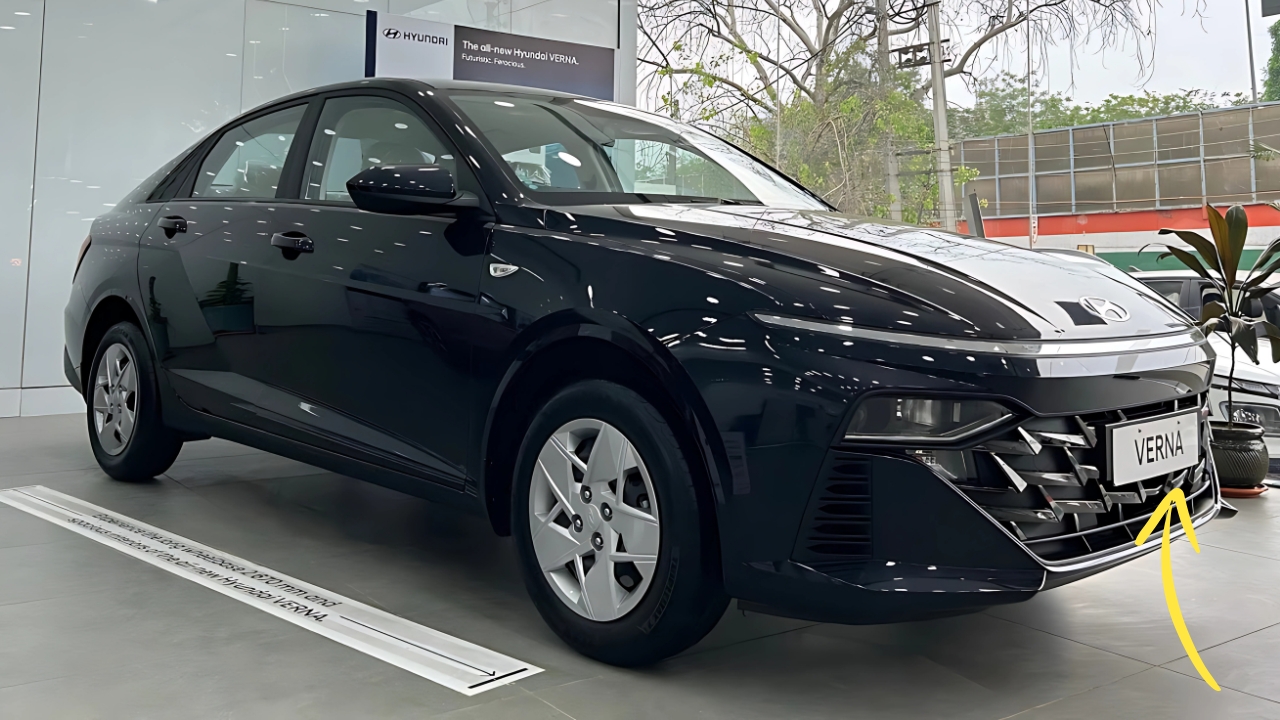Hyundai Verna: The Hyundai Verna continues to evolve its market strategy in 2025 with the introduction of a strategically positioned SX+ variant, demonstrating the Korean automaker’s commitment to maintaining its competitive edge in India’s sedan segment. While facing headwinds from the SUV-dominated market, the Verna has carved out a distinctive niche through continuous product refinement and feature enhancement.
Strategic Variant Addition Addresses Market Gap
Hyundai recently launched the new SX+ variant priced at ₹13.79 lakh for the manual transmission and ₹15.04 lakh for the IVT automatic. This mid-specification offering fills a crucial gap between the SX and SX(O) variants, making premium features more accessible to a broader customer base.
The SX+ variant includes coveted features such as LED headlamps, front parking sensors, 16-inch alloy wheels, and a rear spoiler. Interior appointments feature an eight-speaker Bose sound system, heated and ventilated front seats with leatherette upholstery, six airbags, and a comprehensive suite of safety systems including ABS with EBD, ESC, TPMS, and a rearview camera.
This strategic positioning allows customers to access luxury features without stepping up to the top-tier variant, reflecting Hyundai’s understanding of price-sensitive Indian market dynamics. The variant is exclusively available with the 1.5-liter naturally aspirated petrol engine producing 113 horsepower and 144 Nm of torque.
Sales Performance Reflects Market Realities
Market data reveals the challenges facing the sedan segment, with Verna recording 930 units in May 2025 compared to 1,005 units in April 2025, representing a seven percent month-on-month decline. Despite this recent dip, the Verna maintains its position as a significant player in the compact sedan space, with 813 units sold according to recent sales leaderboard data.
The sedan segment’s struggles mirror broader industry trends, as SUVs continue to dominate consumer preferences. However, the Verna’s performance demonstrates that well-executed products can still find their audience in traditional body styles. The recent sales figures, while showing monthly fluctuations, indicate steady demand from customers who prioritize the sedan’s inherent advantages of boot space, fuel efficiency, and driving dynamics.

Design Philosophy Continues to Divide Opinion
The current-generation Verna’s bold design language remains a talking point in automotive circles. Featuring Hyundai’s parametric design philosophy, the sedan sports a distinctive front fascia with connected LED positioning lamps spanning the car’s width, complemented by parametric connected LED tail lamps that create a dramatic nighttime signature.
This futuristic styling approach, while garnering praise for its technological integration and premium appearance, has polarized traditional sedan buyers. The design represents Hyundai’s attempt to differentiate the Verna from conventional three-box sedans, positioning it as a more lifestyle-oriented choice rather than merely a practical family car.
The cabin continues the modern theme with a 10.25-inch HD touchscreen infotainment system paired with a digital instrument cluster. The innovative switchable infotainment and climate controller represents a segment-first feature, allowing drivers to control both systems through the same interface.
Powertrain Excellence Maintains Competitive Edge
The Verna’s engine lineup remains its strongest selling point, offering customers a choice between naturally aspirated and turbocharged 1.5-liter petrol units. The naturally aspirated engine delivers 115 horsepower and 144 Nm of torque, providing adequate performance for daily driving while maintaining excellent fuel efficiency ratings of 18.6 to 20.6 kilometers per liter.
The highlight remains the 1.5-liter turbo-petrol engine, which produces 160 horsepower and 253 Nm of torque – making it the most powerful engine in its segment. This powerplant outperforms rivals by a significant margin, offering 10 horsepower more than the German twins and substantially more than hybrid alternatives.
Transmission options include a six-speed manual, CVT automatic for the naturally aspirated engine, and a seven-speed DCT for the turbo variant. The DCT transmission, in particular, has received praise for its smooth operation and quick shifts, enhancing the sporty character of the turbo variants.
Safety and Technology Integration
The Verna’s commitment to safety remains evident through its five-star Global NCAP rating and comprehensive feature list. Standard equipment includes six airbags across all variants, Level 2 ADAS functionality on higher trims, and essential safety systems like ABS, EBD, ESC, and hill hold assist.
Technology integration extends beyond safety, with features like a Bose premium sound system, wireless charging, multiple USB-C ports, and smartphone connectivity options. The recent introduction of a wireless adapter for Android Auto and Apple CarPlay on select variants demonstrates Hyundai’s responsiveness to customer feedback.
POCO F6 smartphone launched with gaming processor – price is low
Hyundai Verna Market Positioning and Future Outlook
Despite facing a challenging market environment where SUVs command 67.6 percent of Hyundai’s sales mix, the Verna continues to serve as an important portfolio product. Its role extends beyond pure volume generation to brand image enhancement and customer retention within the sedan segment.
Recent price adjustments of approximately ₹7,000 across variants reflect inflationary pressures and rising input costs. However, ongoing promotional offers, including exchange bonuses up to ₹1,00,000 and extended warranty packages, help maintain value proposition competitiveness.
The Verna’s success in maintaining relevance despite segment decline demonstrates Hyundai’s product development prowess and market understanding. As the automotive industry transitions toward electrification and changing mobility patterns, the current Verna represents a mature expression of internal combustion engine technology combined with modern conveniences and safety features.